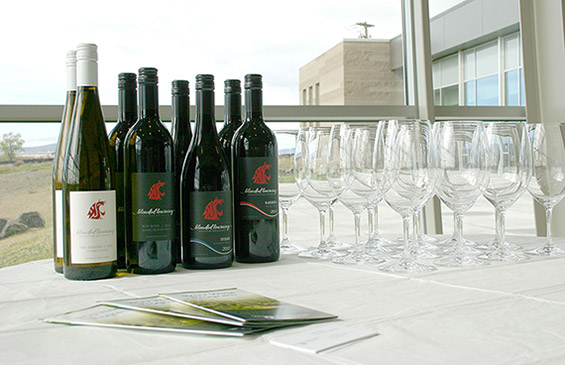Pros ser, Wash. — When he founded the Blended Learning winemaking course three years ago, Thomas Henick-Kling had an important choice to make: How to seal his department’s student-created wines. “For me, there was no question,” said Henick-Kling, director of Washington State University’s Viticulture and Enology program. “We were going to put them under screw caps.”
ser, Wash. — When he founded the Blended Learning winemaking course three years ago, Thomas Henick-Kling had an important choice to make: How to seal his department’s student-created wines. “For me, there was no question,” said Henick-Kling, director of Washington State University’s Viticulture and Enology program. “We were going to put them under screw caps.”
Traditional cork, with its iconic pop, lost out to the humble aluminum cap—and for good reasons.
“It’s the best technology for closing wine in a glass bottle,” says Henick-Kling, who is out to dispel old myths about caps being an inferior product typically used for cheap wine. He chose caps to avoid a common problem called cork taint. “I’m a rationalist,” he says, explaining his decision. “It makes sense.”
‘CORKY’ CONCERN
For the past six years, every wine made by a WSU student or researcher has gone under screw cap.
“We’re not interested in dealing with cork-tainted wines,” says Jim Harbertson, WSU associate professor of enology.
Cork taint can wreck as many as seven bottles of wine out of a hundred. Tainted wines may have a moldy, musty, off-putting smell, or hardly any smell at all—either way, your sipping experience is ruined.
Cork taint is mainly caused by two compounds, trichloroanisole and tribromoanisole, known as TCA and TBA. They develop anywhere that wood, water, chlorine and microorganisms combine. Even store-bought fruit can be ‘corky,’ says Henick-Kling, if it’s transported on pallets that happen to get splashed by chlorinated water.
“Dump chlorinated water onto wood or cardboard, and boom, you have TCA,” says Henick-Kling. “You only need parts per trillion, tiny amounts,” for the chemical to be detectable.
In the Blended Learning program, enology students learn how to make and market their own wines over the course of a year, developing their product to commercial standards in partnership with Washington wineries. Blended Learning produces a small run.
“200 cases is a lot for us,” says Henick-Kling. Yet even in a limited run, “I save, because I don’t have to accept a failure rate of two to seven percent, or in some cases even higher.”
Inconsistency in natural corks would be a big problem in the small number of bottles the university produces for research, Harbertson points out.
“We cannot simply discard several and look for one with a good closure,” he adds. “Every bottle needs to reflect the quality of wine produced for a particular research project.”
Bigger wineries have made the same switch to caps for the same reason. “If a consumer opens their wine, and it happens to be corky and they don’t like it, they may not know it’s the cork. They blame the winery,” says Henick-Kling.
BREATH IN, BREATH OUT
Today, about 80 percent of the world’s 20 billion bottles produced annually are sealed with cork made from the bark of the cork oak tree.
Cork is spongy enough to be forced into the neck of a wine bottle, but expands to form a seal. Cork quality can vary, however, and wines can breathe or age differently depending on cork variability.
“A perfect cork doesn’t let in air,” said Henick-Kling. A bad cork will quickly oxidize wine. The problem, he said, is there is no practical way to test every cork, so winemakers always run a risk of a corky or poorly aged wine.
Under caps, “you can control oxidation. You can completely keep it out, or allow a small, controlled amount of oxygen to get in,” Henick-Kling added. Airflow through a cap is controlled by the kind of plastic liner that forms the seal. Some liners breathe, others don’t. “With a screw cap, I don’t have to worry. It’ll be fine for 20 years or longer.”
PROS & CONS
Researchers are studying how wine—and consumers—react to different closures.
“There is interest in the industry to see how these wines change,” said WSU food scientist Carolyn Ross. A 2007 study by scientists with the Australian Wine Research Institute looked at changes in wine properties during two years of storage under cork and caps.
“The chemical reactions that occur in the wine vary with the closure, due to the different amount of oxygen that is present,” she says. Under caps, Australian researchers found in some wines reduced aromas—unwanted sulfur compounds smelling subtly of rubber, mocha or struck flint. Reduced aromas can also develop under corks. It takes time for these aromas to develop. “A lot of people drink their wine before they see change,” Ross says.
A 2007 study at Oregon State University looked at how different closures affect consumers’ purchase intent and price expectation. The study found consumers are willing to pay less for caps. Ross suspects the situation may have changed since then.
“People are understanding it more,” she says. “They’re exposed to more screwcaps now, on higher quality wines. People who are really experienced with wines may have already worked through that.”
Aesthetically, caps and corks are different. Screw caps twist off. It requires some finesse with a corkscrew to open, but the satisfying pop when the cork comes free is a traditional sound of celebration.
“There’s a certain, satisfying sound, and a certain feel, when you’re removing the cork,” says Harbertson. “I would miss that. But I don’t want the hassle of cork taint. Most of us would prefer not to deal with it.”
